Class 10 Exam > Class 10 Notes > Physics for GCSE/IGCSE > Real & Virtual Images
Real & Virtual Images | Physics for GCSE/IGCSE - Class 10 PDF Download
| Table of contents |

|
| Introduction |

|
| Converging Lens - Real Image |

|
| Converging Lens - Virtual Image |

|
| Diverging Lens - Virtual Image |

|
Introduction
When lenses form images, they fall into two categories:
- real images and
- virtual images.
Real Image
- A real image is created when light rays from an object come together and intersect, capable of being projected onto a surface.
- It results from the convergence of light rays towards a focal point.
- Real images are consistently upside down.
- They can be projected onto screens or surfaces, such as paper.
- A classic illustration of a real image is the one seen on a cinema screen.
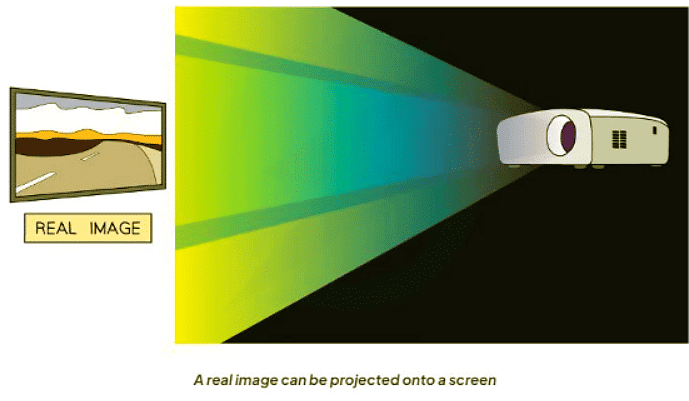
- Real images are represented in ray diagrams by the intersection of two solid lines.
Virtual Image
- A virtual image is defined as an image that appears to be located at a point where light rays appear to diverge from, rather than actually converging there.
- Virtual images are always upright and cannot be projected onto a screen.
- An example of a virtual image is a person's reflection in a mirror.
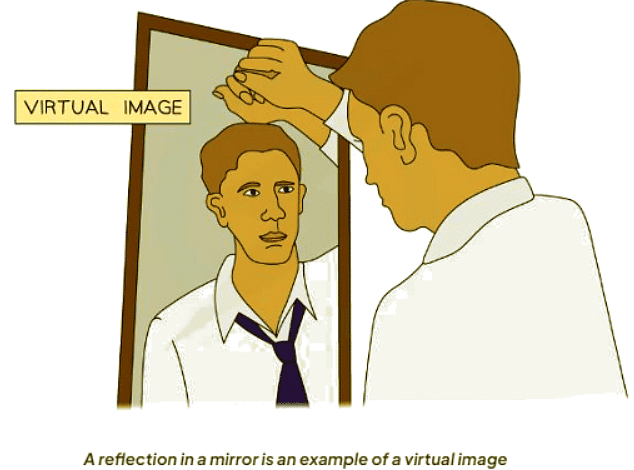
- Virtual images are represented where two dashed lines or one dashed and one solid line intersect in ray diagrams.
Converging Lens - Real Image
- Lenses have the capability to create images of objects positioned in front of them.
- The position and characteristics of the image can be determined by constructing a ray diagram:
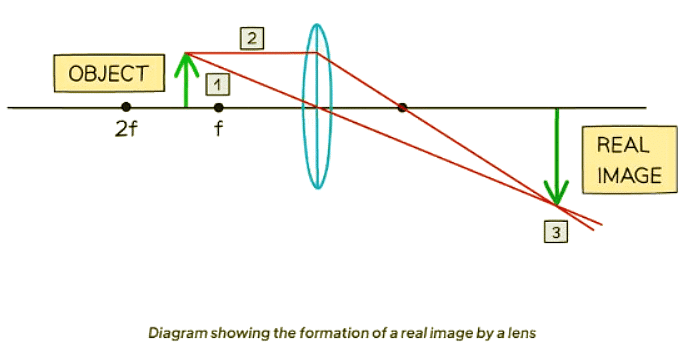
- Lenses have the ability to generate images of objects situated before them.
- The position and characteristics of the image can be determined by constructing a ray diagram:
- Begin by drawing a ray from the object's top through the lens center. This ray proceeds in a straight line.
- Subsequently, draw a ray from the top of the object parallel to the axis towards the lens. Upon exiting the lens, this ray moves directly towards the principal focus.
- The point where the two aforementioned rays intersect signifies the image location.
- When an object is positioned between one focal length (f) and two focal lengths (2f) from a lens:
- The resulting image is real, enlarged, and inverted.
- Real
- Enlarged
- Inverted
- When the object is beyond twice the focal length (2f) from the lens:
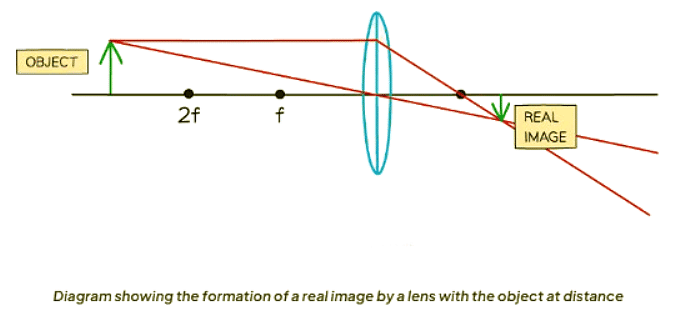
- The image is real, diminished (smaller), and inverted in this scenario.
- Real
- Diminished (smaller)
- Inverted
- When the object is precisely at twice the focal length (2f) from the lens:
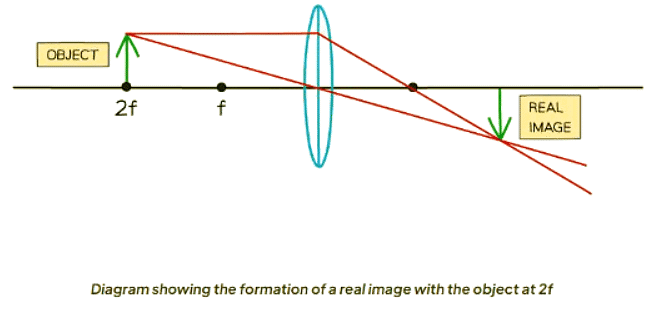
- In this case the image is:
- Real
- Same size as the object
- Inverted
Question for Real & Virtual ImagesTry yourself: What is a real image?View Solution
Converging Lens - Virtual Image
- If an object is positioned beyond the focal length of a converging lens, it will generate a real image.
- However, when the object is placed nearer to the lens than its focal length, a virtual image will emerge, and the ray diagram for the converging lens is constructed as follows:
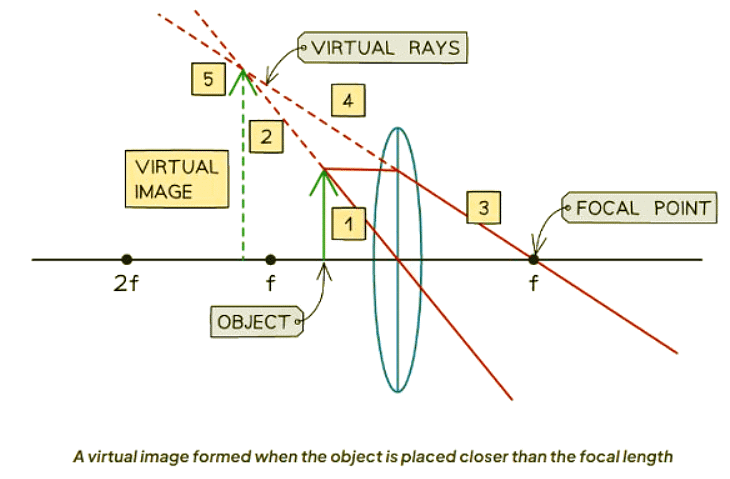
- A virtual image is created when the object is positioned closer to the lens than its focal length.
- Begin by drawing a ray originating from the top of the object and passing through the center of the lens. This ray will travel in a straight line.
- Continue this ray upwards with a dashed line.
- Next, draw a ray starting from the top of the object, moving parallel to the lens's axis. Upon exiting the lens, this ray will pass directly through the principal focus, denoted as 'f'.
- Extend another dashed line upwards from this ray.
- The virtual image is the line drawn from the axis to the point where the two dashed lines intersect.
- Virtual Image Features:
- The virtual image appears to converge when the light rays are extended backward.
- The image is magnified, meaning it is larger than the actual object.
- It is upright, indicating that the image is on the same side as the principal axis.
Diverging Lens - Virtual Image
- Diverging lenses have the ability to create virtual images. These images are always virtual when formed by diverging lenses.
- When an object is positioned farther away from the diverging lens than its focal length (f), a specific ray diagram for the diverging lens is constructed:
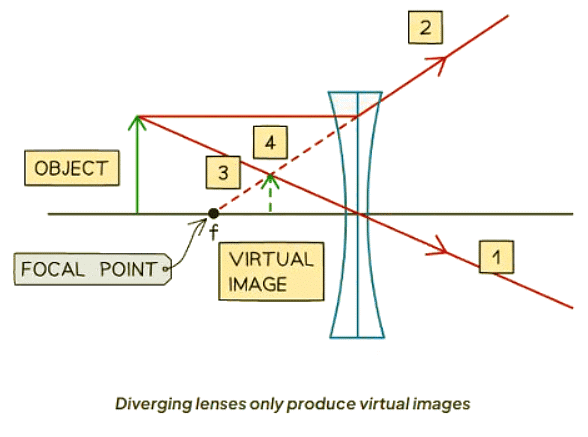
- To begin, draw a ray starting from the top of the object and passing through the center of the lens. This ray will continue along a straight path.
- Following that, draw another ray starting from the top of the object, moving parallel to the lens's axis. After passing through the lens, this ray will move vertically upwards away from the lens's axis.
- Extend a dashed line from where this ray exits the lens to the lens's focal point, denoted as f.
- The virtual image is formed by drawing a line from the lens's axis to the point of intersection of the above two rays.
- In this scenario, the image is:
- Virtual: Light rays seem to intersect when traced backward.
- Diminished: The image is smaller compared to the object.
- Upright: Formed on the same side of the principal axis.
Comparing Converging & Diverging Lenses
- A converging lens can create either a real or virtual image, indicating it can be inverted (real) or upright (virtual).
- A diverging lens consistently produces a virtual image, meaning it will always be upright.
The document Real & Virtual Images | Physics for GCSE/IGCSE - Class 10 is a part of the Class 10 Course Physics for GCSE/IGCSE.
All you need of Class 10 at this link: Class 10
|
126 videos|194 docs|35 tests
|
FAQs on Real & Virtual Images - Physics for GCSE/IGCSE - Class 10
| 1. What is the difference between a real image and a virtual image formed by a converging lens? |  |
Ans. A real image is formed when light rays actually converge at a point on the opposite side of the lens, while a virtual image is formed when the light rays only appear to converge at a point, but do not actually meet.
| 2. How does a converging lens create a real image? |  |
Ans. A converging lens creates a real image by refracting light rays that pass through it and converging them to a point on the opposite side of the lens, where the real image is formed.
| 3. Can a diverging lens form a virtual image? |  |
Ans. Yes, a diverging lens can form a virtual image. This occurs when the diverging lens refracts light rays in such a way that they diverge and appear to converge at a point on the same side of the lens, forming a virtual image.
| 4. How can you determine the size and location of a virtual image formed by a converging lens? |  |
Ans. The size and location of a virtual image formed by a converging lens can be determined using ray diagrams and the lens formula, which take into account the object distance, image distance, and focal length of the lens.
| 5. What are some real-world applications of real and virtual images formed by lenses? |  |
Ans. Real images formed by lenses are used in devices such as cameras and projectors, where a focused image is needed. Virtual images are used in systems like microscopes and telescopes, where an enlarged and upright image is required for observation.
Related Searches














